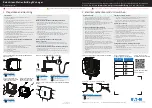
yellow
blue
1-24
When should an air bag inflate?
The driver’s and right front passenger’s frontal air bags
are designed to inflate in moderate to severe frontal or
near
-
frontal crashes. The frontal air bags are designed to
inflate only if the impact speed is above the system’s
designed “threshold level.” If your vehicle goes straight
into a wall that doesn’t move or deform, the threshold
level is about 9 to 15 mph (14 to 24 km/h). The
threshold level can vary, however, with specific vehicle
design, so that it can be somewhat above or below this
range. If your vehicle strikes something that will move
or deform, such as a parked car, the threshold level will
be higher. The driver’s and right front passenger’s
frontal air bags are not designed to inflate in rollovers,
side impacts, or rear impacts, because inflation would
not help the occupant.
The driver’s and right front passenger’s side impact air
bags are designed to inflate in moderate to severe side
crashes involving a front door. A side impact air bag
will inflate if the crash severity is above the system’s
designed “threshold level.” The threshold level can vary
with specific vehicle design. Side impact air bags are not
designed to inflate in frontal or near
-
frontal impacts,
rollovers or rear impacts, because inflation would not
help the occupant. A side impact air bag will only
deploy on the side of the vehicle that is struck.
In any particular crash, no one can say whether an air
bag should have inflated simply because of the damage
to a vehicle or because of what the repair costs were. For
frontal air bags, inflation is determined by the angle of
the impact and how quickly the vehicle slows down in
frontal and near
-
frontal impacts. For side impact air
bags, inflation is determined by the location of the
impact and how quickly the side of the vehicle deforms.
What makes an air bag inflate?
In an impact of sufficient severity, the air bag sensing
system detects that the vehicle is in a crash. For both
frontal and side impact air bags, the sensing system
triggers a release of gas from the inflator, which inflates
the air bag. The inflator, air bag and related hardware
are all part of the air bag modules inside the steering
wheel, instrument panel and the side of the front
seatbacks closest to the door.
Summary of Contents for 1999 Seville
Page 6: ...yellowblue vi NOTES...
Page 114: ...yellowblue 2 62 The Instrument Panel Your Information System...
Page 180: ...yellowblue 3 36 NOTES...
Page 189: ...yellowblue 3 45 NOTES...
Page 190: ...yellowblue 3 46 NOTES...
Page 230: ...yellowblue 4 40 NOTES...
Page 231: ...yellowblue 4 41 NOTES...
Page 232: ...yellowblue 4 42 NOTES...
Page 262: ...yellowblue 5 30 NOTES...
Page 263: ...yellowblue 5 31 NOTES...
Page 264: ...yellowblue 5 32 NOTES...
Page 334: ...yellowblue 6 70 NOTES...
Page 348: ...yellowblue 7 14 NOTES...
















































